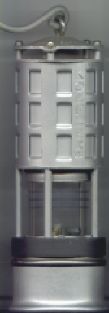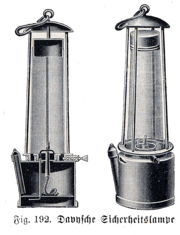
Safety lamp
Encyclopedia

Light fixture
A light fixture, light fitting, or luminaire is an electrical device used to create artificial light and/or illumination, by use of an electric lamp...
, which are designed to be safe to use in coal mines. These lamps are designed to operate in air that may contain coal dust
Coal dust
Coal dust is a fine powdered form of coal, which is created by the crushing, grinding, or pulverizing of coal. Because of the brittle nature of coal, coal dust can be created during mining, transportation, or by mechanically handling coal.-Explosions:...
, methane
Methane
Methane is a chemical compound with the chemical formula . It is the simplest alkane, the principal component of natural gas, and probably the most abundant organic compound on earth. The relative abundance of methane makes it an attractive fuel...
, or firedamp
Firedamp
Firedamp is a flammable gas found in coal mines. It is the name given to a number of flammable gases, especially methane. It is particularly commonly found in areas where the coal is bituminous...
, all of which are potentially flammable or explosive. The use of open lamps, rather than the safety lamps that were then available, was one cause of the Naomi Mine explosion
Naomi Mine explosion
The Naomi Mine Explosion at Fayette City, Pennsylvania happened on December 1, 1907. 34 miners were killed in the explosion. The mine was operated by the United Coal Company, who did not provide modern safety lamps to the miners. The explosion was felt to be due to the ignition of 'black damp' by...
and the Darr Mine Disaster
Darr Mine Disaster
The Darr Mine Disaster at Van Meter, Rostraver Township, Westmoreland County, Pennsylvania, near Smithton, killed 239 men and boys on December 19, 1907. It ranks as the worst coal mining disaster in Pennsylvania history...
in Pennsylvania
Pennsylvania
The Commonwealth of Pennsylvania is a U.S. state that is located in the Northeastern and Mid-Atlantic regions of the United States. The state borders Delaware and Maryland to the south, West Virginia to the southwest, Ohio to the west, New York and Ontario, Canada, to the north, and New Jersey to...
in December 1907.
First safety lamps
The first safety lamp was invented by William Reid ClannyWilliam Reid Clanny
William Reid Clanny was an Irish inventor.He was born in Bangor, County Down, Ireland. He moved to Sunderland, England and practised as a physician for 45 years.In 1813, he invented the Clanny safety lamp for miners...
, an Irish physician, who announced his discovery on May 20, 1813 at the Royal Society of Arts
Royal Society of Arts
The Royal Society for the encouragement of Arts, Manufacturers and Commerce is a British multi-disciplinary institution, based in London. The name Royal Society of Arts is frequently used for brevity...
in London, but it was not tried out in a colliery until 1815. Within months of this demonstration, two improved designs had been announced: one by George Stephenson
George Stephenson
George Stephenson was an English civil engineer and mechanical engineer who built the first public railway line in the world to use steam locomotives...
, which later became the Geordie lamp
Geordie lamp
The Geordie lamp was invented by George Stephenson in 1815 as a solution to explosions due to firedamp in coal mines.Although controversy arose between Stephenson's design and the Davy lamp, , Stephenson's original design worked on significantly different principles...
, and the Davy lamp
Davy lamp
The Davy lamp is a safety lamp with a wick and oil vessel burning originally a heavy vegetable oil, devised in 1815 by Sir Humphry Davy. It was created for use in coal mines, allowing deep seams to be mined despite the presence of methane and other flammable gases, called firedamp or minedamp.Sir...
, invented by Sir Humphry Davy
Humphry Davy
Sir Humphry Davy, 1st Baronet FRS MRIA was a British chemist and inventor. He is probably best remembered today for his discoveries of several alkali and alkaline earth metals, as well as contributions to the discoveries of the elemental nature of chlorine and iodine...
. Most later lamps are constructed on the principle discovered by Davy, that a flame enveloped in wire gauze
Gauze
Gauze is a thin, translucent fabric with a loose open weave.-Uses and types:Gauze was originally made of silk and was used for clothing. It is now used for many different things, including gauze sponges for medical purposes. When used as a medical dressing, gauze is generally made of cotton...
of a certain fineness does not ignite firedamp
Firedamp
Firedamp is a flammable gas found in coal mines. It is the name given to a number of flammable gases, especially methane. It is particularly commonly found in areas where the coal is bituminous...
.
Both the Davy and Stephenson lamps were fragile. The gauze in the Davy quickly rusted in the moist air of a coal pit, and so became unsafe, while the glass in the Stephenson was easily broken, and could then allow the flame to ignite firedamp in the atmosphere. Later designs, the Gray, Mueseler, Marsaut, and other lamps, tried to overcome these problems by using multiple gauze cylinders, but the glass remained a problem until toughened glass
Toughened glass
Toughened or tempered glass is a type of safety glass processed by controlled thermal or chemical treatments to increase its strength compared with normal glass. Tempering creates balanced internal stresses which cause the glass, when broken, to crumble into small granular chunks instead of...
became available.
Also, the light that all these gave was poor and this was not solved until the introduction of electric lighting in mines around 1900. But it took until 1930 for the introduction of battery-powered helmet lamps to finally solve the problem.
Early illumination

Barometer
A barometer is a scientific instrument used in meteorology to measure atmospheric pressure. Pressure tendency can forecast short term changes in the weather...
s were used to tell them if atmospheric pressure
Atmospheric pressure
Atmospheric pressure is the force per unit area exerted into a surface by the weight of air above that surface in the atmosphere of Earth . In most circumstances atmospheric pressure is closely approximated by the hydrostatic pressure caused by the weight of air above the measurement point...
was low (in which case more methane seeped out of the coal seams into the mine galleries).
The use of small mammals or birds was used much later at the end of the Victorian age to warn of the presence of the deadly carbon monoxide present after underground fires or explosions, the so-called afterdamp
Afterdamp
Afterdamp is the toxic mixture of gases left in a mine following an explosion caused by firedamp, which itself can initiate a much larger explosion of coal dust. It consists of carbon dioxide, carbon monoxide and nitrogen. Hydrogen sulfide, another highly toxic gas, may also be present...
. The method was introduced by the noted physiologist and disaster investigator, John Scott Haldane after the Laxey
Laxey
Laxey is a village on the east coast of the Isle of Man. Its name derives from the Old Norse Laxa meaning 'Salmon River'.The village lies on the A2, the main Douglas to Ramsey road. Laxey Glen is one of the Manx National Glens, with Dhoon Glen being located close by...
lead mine disaster. Such animals are much more susceptible to the gas, and will die before a human, so giving an early warning of the problem. There were numerous deaths caused by carbon monoxide
Carbon monoxide
Carbon monoxide , also called carbonous oxide, is a colorless, odorless, and tasteless gas that is slightly lighter than air. It is highly toxic to humans and animals in higher quantities, although it is also produced in normal animal metabolism in low quantities, and is thought to have some normal...
from a small fire near one of the shaft bottoms. An alternative method of removing a different gas, known as firedamp
Firedamp
Firedamp is a flammable gas found in coal mines. It is the name given to a number of flammable gases, especially methane. It is particularly commonly found in areas where the coal is bituminous...
(methane) involved igniting the gas deliberately to cause explosions, thus evacuating the mines of the majority of explosive or easily flammable material present.
The lack of good lighting was a prime cause of a painful eye affliction (nystagmus).
Modern lamps
Nowadays, safety lamps are mainly electric, and traditionally mounted on miners' helmets (such as the wheat lampWheat lamp
A wheat lamp is a type of incandescent light designed for use in underground mining, named for inventor Grant Wheat and manufactured by Koehler Lighting Products in Wilkes-Barre, Pennsylvania, United States, a region known for extensive mining activity...
) or the Oldham headlamp, sealed to prevent gas penetrating the casing and being ignited by electrical sparks.
Although its use as a light source was superseded by electric lighting, the flame safety lamp has continued to be used in mines to detect methane
Methane
Methane is a chemical compound with the chemical formula . It is the simplest alkane, the principal component of natural gas, and probably the most abundant organic compound on earth. The relative abundance of methane makes it an attractive fuel...
and blackdamp
Blackdamp
Blackdamp is an asphyxiant, reducing the available oxygen content of air to a level incapable of sustaining human or animal life. It is not a single gas but a mixture of unbreathable gasses left after oxygen is removed from the air and typically consists of nitrogen, argon, carbon dioxide and...
, although many modern mines now also use sophisticated electronic gas detectors for this purpose.
As a new light source, LED
LEd
LEd is a TeX/LaTeX editing software working under Microsoft Windows. It is a freeware product....
has many advantages for safety lamps, including longer burn time and less energy required. Combined with new battery technologies, such as the lithium battery, it gives much better performance in safety lamp applications. It is replacing conventional safety lamps.
See also
- List of light sources
- PellistorPellistorA pellistor is a solid-state device used to detect gases which are either combustible or which have a significant difference in thermal conductivity to that of air...
- Felling mine disasterFelling mine disasterFelling mine disaster was a major mining accident in Britain, claiming 92 lives on 25 May 1812.The colliery was situated in Felling, Tyne and Wear, part of Gateshead, in what used to be County Durham, and had two shafts about 600 feet deep. It was extended in 1810 by the opening up of a new coal...
- Mining accidentMining accidentA mining accident is an accident that occurs during the process of mining minerals.Thousands of miners die from mining accidents each year, especially in the processes of coal mining and hard rock mining...
- Canary in a coal mine

